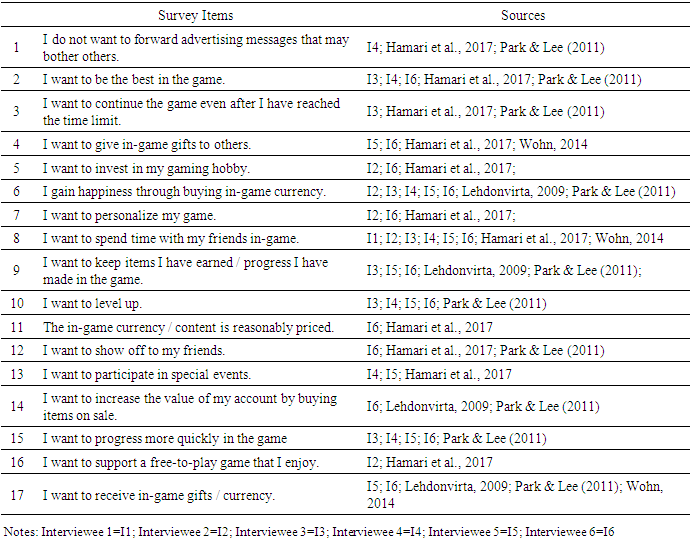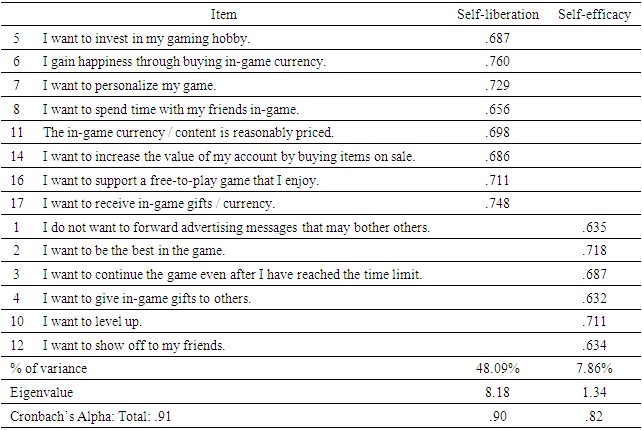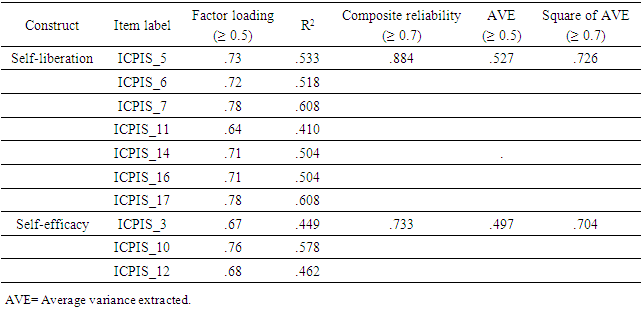-
Paper Information
- Paper Submission
-
Journal Information
- About This Journal
- Editorial Board
- Current Issue
- Archive
- Author Guidelines
- Contact Us
International Journal of Psychology and Behavioral Sciences
p-ISSN: 2163-1948 e-ISSN: 2163-1956
2021; 11(3): 47-52
doi:10.5923/j.ijpbs.20211103.02
Received: Jul. 9, 2021; Accepted: Nov. 10, 2021; Published: Nov. 28, 2021

In-game Content Purchase Intention Scale (ICPIS): Scale Development and Validation
Yida Y. H. Chung1, Eliza L. Y. Lau2
1Felizberta Lo Padilla Tong School of Social Sciences, Caritas Institute of Higher Education, HKSAR
2Doctoral of Education Student, University of Bristol, U. K.
Correspondence to: Yida Y. H. Chung, Felizberta Lo Padilla Tong School of Social Sciences, Caritas Institute of Higher Education, HKSAR.
| Email: |  |
Copyright © 2021 The Author(s). Published by Scientific & Academic Publishing.
This work is licensed under the Creative Commons Attribution International License (CC BY).
http://creativecommons.org/licenses/by/4.0/

The purpose of this study is to develop and validate the In-game Content Purchase Intention Scale (ICPIS) to study the intention of Chinese online game players to purchase in-game content. The scale’s initial questionnaire items were developed by referring to the current literature and conducting interviews with six online game players. Specialists in the subject (n=5) were consulted to fine-tune the scale. The construct validation study (n=287) was undertaken after a pilot survey (n=10). Self-liberation and self-efficacy are the two dimensions that make up the final version of the scale. Overall, the ICPIS reported good convergent, discriminant, and predictive validity. Implications and future research directions are discussed. The scale provides a framework for future research in an increasingly vital field.
Keywords: In-game Content Purchase Intention Scale, Intention, Chinese, Online game, Measurement
Cite this paper: Yida Y. H. Chung, Eliza L. Y. Lau, In-game Content Purchase Intention Scale (ICPIS): Scale Development and Validation, International Journal of Psychology and Behavioral Sciences, Vol. 11 No. 3, 2021, pp. 47-52. doi: 10.5923/j.ijpbs.20211103.02.
1. Introduction
- The development of high-performance networks and high-tech mobile devices as well as online payment systems have boosted the popularity of online games and in-game purchases. Newzoo (2021) estimated that the population of game players will reach 2.9 billion by the end of 2021, with 55% of gamers coming from the Asia-Pacific region. Tencent Holdings Limited (2021), a leading online communication and social platform technology corporation in China, announced a 36 percent growth in its online games income for the year ended December 31, 2020. Under the impact of COVID-19 pandemic, there is a dramatic growth in the figures not only in the amount of money spent in online games, but also in the number of hours (Chung, 2021; Xu et al,, 2021). Such critical impact has spurred the attention of the PRC government to curb the growth and to minimize the destructive effects of online games to the minor (CNBC, August 20, 2021).Despite the dramatic growth in the number of online game players, few studies were conducted to investigate the intention of gamers to purchase in-game currency. the nature of the In-game Content Purchase Intention Scale (ICPIS) construct is unknown. While Chinese gamers were in the grip of online game fever (Newzoo, 2021), there is a need to develop a Chinese specific In-game Content Purchase Intention Scale (ICPIS) to explore the relationship between on-line gaming intention and their in-game purchase behaviour. Against this background, the In-game Content Purchase Intention Scale (ICPIS) was developed and validated.
2. Literature Review
- Game payment model developmentThere are a lot of game payment models. Earlier game payment models appeared less explicitly. Instead of asking gamers to buy virtual currency, some game developers may require gamers to pay telecommunication bills, network connection fees, music delivery service fees, or value-added service fees. The payment models then evolved to become an option for gamers to purchase in-game currency to exchange for virtual goods, enhance their status, and add points in paid / free-to-play games (Wang & Mainwaring, 2008). Nowadays, a lot of free-to-play games provide gamers with the option to buy in-game content. Research studies suggested that virtual game currency may give gamers special value in the gaming world (Guo et al., 2019; Zendle et al., 2019). They found that gamers purchased in-game content with either the intention to earn money or to win. Purchasing In-game contentA review of literature showed that four systematic studies were conducted to identify motivational factors behind the in-game content purchasing behaviour in recent years (Hamari et al., 2017; Lehdonvirta, 2009; Park & Lee, 2011; Wohn, 2014). Of these studies, Hamari et al. (2017) examined the motivations (i.e. unobstructed play, social interaction, competition, and economical rationale) for purchasing in-game content among online game players. Lehdonvirta (2009) identified functional, hedonic, and social attributes among gamers who purchase virtual goods from massive multiplayer online games. Park and Lee (2011) investigated gamers’ perception of consumption values (i.e. character competency value, enjoyment value, visual authority value and monetary value). Wohn (2015) researched the relationship between social factors and in-game content purchase patterns. The common factors for purchasing in-game content consolidated from these studies are “game level advancement”, “enjoyment”, “social connection” and “value for money”. These factors provide a valuable reference for the current research into game players’ motivation to purchase online game items. In light of this, the current study focuses on motivational factors behind the in-game content purchase behaviour and the psychometric properties of the scale among Hong Kong online game players.
3. Method
- ParticipantsThe study comprised 287 participants, of which 73.2% were male (n=210) and 26.8% were female (n=77). The age range of participants was between 15 and 40 with an average of 26.6 years old (SD=6.5). All of them resided in Hong Kong, with a majority of them were Chinese (93.4%), the remaining were from Japan, Macau, Ireland, Singapore, and Taiwan. 30.0% of the participants were student (n=86), 22.3% were professionals (n=64), 9.4% were managers and administrator (n=27), 8.0% were service worker (n=23), 7.7% were associate professional (n=22), 6.6% were clerical worker (n=19), 3.1% were unemployed, 1.4% were housewife, the remaining were full-time workers from different fields. Among those participants, 71.1% reported that they had attained tertiary or above education, while the remaining got secondary school or lower education level at the time of the study.Data collectionThis cross-sectional study was conducted from March to June 2020. Purposive sampling was adopted to collect data. Subject inclusion criteria included any Hong Kong residents who were over the age of 15, who had purchased in-game content while playing online games one month prior to the study. Subjects were recruited via online game pages and general online game chat groups. Socio-demographics and game-related data (e.g., time spent on playing online games every day, monthly spending on purchases, favorite types of online games) were gathered through an online questionnaire. Each respondent took approximately 20 minutes to complete the survey. Ethical approval was obtained from the Human Research and Ethics Committee of the Caritas Institute of Higher Education (Reference No. HRE200101). All subjects gave their written informed consent before joining the online survey. All those 410 respondents of our survey had in-game content purchase practice. Before they were selected for the survey, 287 of them had paid for in-game items one month prior to our survey started. Development of the In-game Content Purchase Intention Scale (ICPIS)The original 17-item ICPIS was developed after reviewing literature about reasons for paying for the online in-game items (Hamari et al., 2017; Lehdonvirta, 2009; Park & Lee, 2011; Wohn, 2014), and the results from interviewing six online game players who purchased in-game contents. The factors leading to in-game purchase decisions were translated into Chinese from English and back-translated again to ensure consistency and face validity (See Table 1). The 17-item ICPIS scale was pilot tested with ten online game players before it was administered to the respondents to find out their reasons for purchasing in-game contents. Respondents were invited to rate how they agreed with the statement on a 6-point Likert scale (1=strongly disagree, 6=strongly agree).
|
4. Results
- Exploratory Factor Analysis (EFA) of the In-game Content Purchase Intention ScaleEFA was tested in SPSS (Version 21). The value for the Kaiser-Meyer-Olkin Measure of Sampling Adequacy (KMO) was 0.927, representing a meritorious degree of inter-correlations among the items. The value justified the appropriateness of applying factor analysis (Hair et al., 2010). By Bartlett’s Test of Sphericity, the value was 2673 which shows sufficient evidence to reject that the correlation matrix is identity matrix (p-value < 0.001). As a whole, the EFA is very useful in presenting this case. A principal-components analysis was performed on the 17-item In-game Currency Purchase Scale. Cattell’s scree test showed that 3 factors were possible. Varimax rotation PCA revealed 3 components had eigenvalues greater than one. To avoid overestimating the factor loadings, a parallel analysis was also applied (Lim & Jahng, 2019). Examination of the result generated from the Monte Carlo Simulator indicated that only the first 2 actual eigenvalues were greater than those generated by PA and thus would be retained. Coefficients less than 0.5 were suppressed. ICPIS_9, ICPIS_13, and ICPIS_15 were cross-loading items, hence, being removed. Finally, the two-component solution met the interpretability criterion which explained 55.95% of the total variance. Eight items loaded highest on the first factor (eigenvalue =8.18), accounting for 48.09% of the total variance. These 8 items were “I want to invest in my gaming hobby”, “I gain happiness through buying in-game currency”, “I want to personalize my game”, “I want to spend time with my friends in-game”, “The in-game content is reasonably priced, “I want to increase the value of my account by buying items on sale”, “I want to support a free-to-play game that I enjoy”, and “I want to receive in-game gifts / currency”. These items loading on this factor tapped players commitment in the games and their purchase for liberation in the game world which could be termed “self-liberation”. The second factor was composed of 6 items (eigenvalue=1.34), accounting for 7.86% of the variance. This factor encompassed items involving players’ expression of competence, included “I do not want to forward advertising messages that may bother others”, “I want to be the best in the game”, “I want to continue the game even after I have reached the time limit”, “I want to give in-game gifts to others”, “I want to level up”, and “I want to show off to my friends”. These expressions were labeled as “self-efficacy”. The overall reliability analysis with Cronbach’s alpha showed that 14-item In-game Content Purchase Intention Scale was reliable (α= .91) and the subscales were good, showing good internal consistency (Table 2). It was found that all subscales of In-game Content Purchase Scale were significantly correlated with each other. The correlations of the subscales were presented in Table 3.
|
|
|
|
5. Discussion
- The present study investigated the psychometric properties of the ICPIS. The study is a pioneer research in Hong Kong contributing to a better understanding of Chinese online game players’ intention to purchase in-game content. The 10-item ICPIS was validated using a reliable empirical assessment tool to investigate the in-game content purchase behavior of online game players in Hong Kong. Nonetheless, this study has several limitations. First, the study employed a cross-sectionall methodology, which limited its generalizability. Second, it is difficult to determine the exact sample population of online game players that purchase in-game content using purposive sampling as a study sampling approach. Hechathorn (2011) proposed adapting sample approaches such as snowball sampling, respondent-driven, and chain-referral sampling to incorporate various types of online gaming players in response to this research hurdle. Third, the findings may be limited to the Hong Kong population. Despite those limitations mentioned above, the findings from this study address the issue of game players paying in the online game to gain their self-control in social connection and emotional management. The findings give insight to social work practitioner in working with game players on their divided self-concept in real and virtual world. The practitioners can render appropriate services to help players to construct an integrated self-concept and prevent them from indulging in online games. In research area, the divided self-concept may be a predicting factor for their internet gaming disorder. Hence, we suggested investigating into the correlation of online game players’ self-perception and internet addiction in future research.
ACKNOWLEDGEMENTS
- This study was supported by funding from Junior Chamber International (North District) and Sunshine Lutheran Centre.
 Abstract
Abstract Reference
Reference Full-Text PDF
Full-Text PDF Full-text HTML
Full-text HTML



